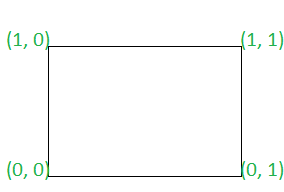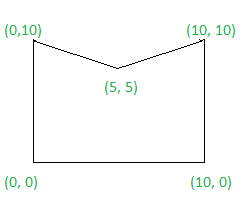给定一个二维数组point[][] ,每一行的形式为{X, Y} ,代表一个多边形顺时针或逆时针顺序的坐标,任务是检查多边形是否是凸多边形.如果发现是真的,则打印“是” 。否则,打印“否” 。
In a convex polygon, all interior angles are less than or equal to 180 degrees
例子:
Input: arr[] = { (0, 0), (0, 1), (1, 1), (1, 0) }
Output: Yes
Explanation:

Since all interior angles of the polygon are less than 180 degrees. Therefore, the required output is Yes.
Input : arr[] = {(0, 0), (0, 10), (5, 5), (10, 10), (10, 0)}
Output : No
Explanation:

Since all interior angles of the polygon are not less than 180 degrees. Therefore, the required output is No.
处理方法:按照以下步骤解决问题:
- 遍历数组,检查多边形任意两条相邻边的叉积方向是否相同。如果发现是真的,则打印“是” 。
- 否则,打印“否” 。
下面是上述方法的实现:
C++
// C++ program to implement
// the above approach
#include
using namespace std;
// Utility function to find cross product
// of two vectors
int CrossProduct(vector >& A)
{
// Stores coefficient of X
// direction of vector A[1]A[0]
int X1 = (A[1][0] - A[0][0]);
// Stores coefficient of Y
// direction of vector A[1]A[0]
int Y1 = (A[1][1] - A[0][1]);
// Stores coefficient of X
// direction of vector A[2]A[0]
int X2 = (A[2][0] - A[0][0]);
// Stores coefficient of Y
// direction of vector A[2]A[0]
int Y2 = (A[2][1] - A[0][1]);
// Return cross product
return (X1 * Y2 - Y1 * X2);
}
// Function to check if the polygon is
// convex polygon or not
bool isConvex(vector >& points)
{
// Stores count of
// edges in polygon
int N = points.size();
// Stores direction of cross product
// of previous traversed edges
int prev = 0;
// Stores direction of cross product
// of current traversed edges
int curr = 0;
// Traverse the array
for (int i = 0; i < N; i++) {
// Stores three adjacent edges
// of the polygon
vector > temp
= { points[i],
points[(i + 1) % N],
points[(i + 2) % N] };
// Update curr
curr = CrossProduct(temp);
// If curr is not equal to 0
if (curr != 0) {
// If direction of cross product of
// all adjacent edges are not same
if (curr * prev < 0) {
return false;
}
else {
// Update curr
prev = curr;
}
}
}
return true;
}
// Driver code
int main()
{
vector > points
= { { 0, 0 }, { 0, 1 },
{ 1, 1 }, { 1, 0 } };
if (isConvex(points)) {
cout << "Yes"
<< "\n";
}
else {
cout << "No"
<< "\n";
}
} Java
// Java program to implement
// the above approach
class GFG
{
// Utility function to find cross product
// of two vectors
static int CrossProduct(int A[][])
{
// Stores coefficient of X
// direction of vector A[1]A[0]
int X1 = (A[1][0] - A[0][0]);
// Stores coefficient of Y
// direction of vector A[1]A[0]
int Y1 = (A[1][1] - A[0][1]);
// Stores coefficient of X
// direction of vector A[2]A[0]
int X2 = (A[2][0] - A[0][0]);
// Stores coefficient of Y
// direction of vector A[2]A[0]
int Y2 = (A[2][1] - A[0][1]);
// Return cross product
return (X1 * Y2 - Y1 * X2);
}
// Function to check if the polygon is
// convex polygon or not
static boolean isConvex(int points[][])
{
// Stores count of
// edges in polygon
int N = points.length;
// Stores direction of cross product
// of previous traversed edges
int prev = 0;
// Stores direction of cross product
// of current traversed edges
int curr = 0;
// Traverse the array
for (int i = 0; i < N; i++) {
// Stores three adjacent edges
// of the polygon
int temp[][]= { points[i],
points[(i + 1) % N],
points[(i + 2) % N] };
// Update curr
curr = CrossProduct(temp);
// If curr is not equal to 0
if (curr != 0) {
// If direction of cross product of
// all adjacent edges are not same
if (curr * prev < 0) {
return false;
}
else {
// Update curr
prev = curr;
}
}
}
return true;
}
// Driver code
public static void main(String [] args)
{
int points[][] = { { 0, 0 }, { 0, 1 },
{ 1, 1 }, { 1, 0 } };
if (isConvex(points))
{
System.out.println("Yes");
}
else
{
System.out.println("No");
}
}
}
// This code is contributed by chitranayalPython3
# Python3 program to implement
# the above approach
# Utility function to find cross product
# of two vectors
def CrossProduct(A):
# Stores coefficient of X
# direction of vector A[1]A[0]
X1 = (A[1][0] - A[0][0])
# Stores coefficient of Y
# direction of vector A[1]A[0]
Y1 = (A[1][1] - A[0][1])
# Stores coefficient of X
# direction of vector A[2]A[0]
X2 = (A[2][0] - A[0][0])
# Stores coefficient of Y
# direction of vector A[2]A[0]
Y2 = (A[2][1] - A[0][1])
# Return cross product
return (X1 * Y2 - Y1 * X2)
# Function to check if the polygon is
# convex polygon or not
def isConvex(points):
# Stores count of
# edges in polygon
N = len(points)
# Stores direction of cross product
# of previous traversed edges
prev = 0
# Stores direction of cross product
# of current traversed edges
curr = 0
# Traverse the array
for i in range(N):
# Stores three adjacent edges
# of the polygon
temp = [points[i], points[(i + 1) % N],
points[(i + 2) % N]]
# Update curr
curr = CrossProduct(temp)
# If curr is not equal to 0
if (curr != 0):
# If direction of cross product of
# all adjacent edges are not same
if (curr * prev < 0):
return False
else:
# Update curr
prev = curr
return True
# Driver code
if __name__ == '__main__':
points = [ [ 0, 0 ], [ 0, 1 ],
[ 1, 1 ], [ 1, 0 ] ]
if (isConvex(points)):
print("Yes")
else:
print("No")
# This code is contributed by SURENDRA_GANGWARC#
// C# program to implement
// the above approach
using System;
class GFG
{
// Utility function to find cross product
// of two vectors
static int CrossProduct(int [,]A)
{
// Stores coefficient of X
// direction of vector A[1]A[0]
int X1 = (A[1, 0] - A[0, 0]);
// Stores coefficient of Y
// direction of vector A[1]A[0]
int Y1 = (A[1, 1] - A[0, 1]);
// Stores coefficient of X
// direction of vector A[2]A[0]
int X2 = (A[2, 0] - A[0, 0]);
// Stores coefficient of Y
// direction of vector A[2]A[0]
int Y2 = (A[2, 1] - A[0, 1]);
// Return cross product
return (X1 * Y2 - Y1 * X2);
}
// Function to check if the polygon is
// convex polygon or not
static bool isConvex(int [,]points)
{
// Stores count of
// edges in polygon
int N = points.GetLength(0);
// Stores direction of cross product
// of previous traversed edges
int prev = 0;
// Stores direction of cross product
// of current traversed edges
int curr = 0;
// Traverse the array
for (int i = 0; i < N; i++) {
// Stores three adjacent edges
// of the polygon
int []temp1 = GetRow(points, i);
int []temp2 = GetRow(points, (i + 1) % N);
int []temp3 = GetRow(points, (i + 2) % N);
int [,]temp = new int[points.GetLength(0),points.GetLength(1)];
temp = newTempIn(points, temp1, temp2, temp3);
// Update curr
curr = CrossProduct(temp);
// If curr is not equal to 0
if (curr != 0) {
// If direction of cross product of
// all adjacent edges are not same
if (curr * prev < 0) {
return false;
}
else {
// Update curr
prev = curr;
}
}
}
return true;
}
public static int[] GetRow(int[,] matrix, int row)
{
var rowLength = matrix.GetLength(1);
var rowVector = new int[rowLength];
for (var i = 0; i < rowLength; i++)
rowVector[i] = matrix[row, i];
return rowVector;
}
public static int[,] newTempIn(int[,] points, int []row1,int []row2, int []row3)
{
int [,]temp= new int[points.GetLength(0), points.GetLength(1)];
for (var i = 0; i < row1.Length; i++){
temp[0, i] = row1[i];
temp[1, i] = row2[i];
temp[2, i] = row3[i];
}
return temp;
}
// Driver code
public static void Main(String [] args)
{
int [,]points = { { 0, 0 }, { 0, 1 },
{ 1, 1 }, { 1, 0 } };
if (isConvex(points))
{
Console.WriteLine("Yes");
}
else
{
Console.WriteLine("No");
}
}
}
// This code is contributed by 29AjayKumarJavascript
输出:
Yes时间复杂度: O(N)
辅助空间: O(1)
如果您希望与专家一起参加现场课程,请参阅DSA 现场工作专业课程和学生竞争性编程现场课程。